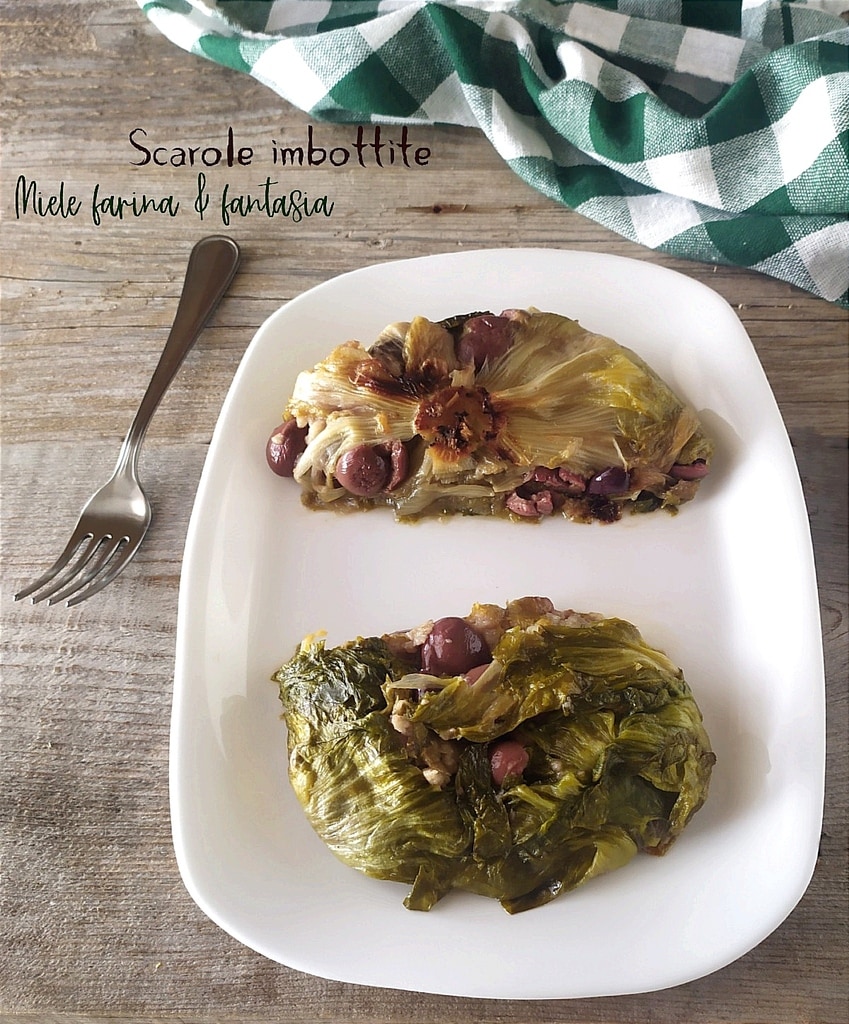Today I will talk about one of my mother’s favorite recipes, the stuffed escarole, a side dish from Neapolitan culinary tradition based on smooth-leaf escarole or endive and a filling that can vary depending on the area. The preparation I will illustrate is based exclusively on my family’s tastes, which I find light and very tasty. Everyone has their own recipe for stuffed escarole or, rather, “scarol mbuttunat.” In some preparations, you will find egg, raisins, Parmesan, or pecorino cheese in the filling. I, however, prepare it like this; you too can personalize the preparation of stuffed escarole according to your needs. If you like this vegetable, here are some tasty ideas for cooking it.

- Difficulty: Very Easy
- Cost: Economical
- Preparation time: 30 Minutes
- Portions: 4
- Cooking methods: Stovetop
- Cuisine: Italian
- Seasonality: Fall, Winter, and Spring
Ingredients
- 10.5 oz escarole (endive) (smooth-leaf)
- 5.3 oz Green and black olives (pitted)
- 3.5 oz Breadcrumbs (also gluten-free)
- 5 fillets Anchovies in oil
- 0.7 oz Pine nuts
- 2 Salted capers
- 1 clove Garlic
- as needed Extra virgin olive oil
- 1 pinch Fine salt
- 1 pinch Ground pepper
- 2 tablespoons Water
Steps
To make stuffed escarole, I use the innermost part (as in the picture below, where the leaves must be well opened), that is, the one with leaves ranging from light green to yellow in the center, the so-called heart of the escarole, much more tender and sweet in flavor.
After removing the outer damaged or inedible leaves, take the part we need, open the leaves as much as possible without breaking them, flip the escarole, and immerse it in a basin full of water to wash it thoroughly. Unused but still edible escarole leaves should not be wasted, as they can be used to make salads or other delicious recipes, which I have linked in the description, that is, at the top part of the recipe.
When the water runs clear, shake the escarole to remove excess water and let it drain in a colander or sieve, keeping it upside down.
Now let’s focus on the filling. In a non-stick pan, placed on the smallest burner on low flame, put the pine nuts and let them toast for about ten minutes, stirring very often. When they are slightly toasted, transfer them to a small plate.
Rinse the capers under running water to remove excess salt. I recommend adding only a pinch of salt in this preparation, as capers, olives, and anchovies are usually very salty.
Take the breadcrumbs and chop them not too finely with a knife or in a food processor, along with the anchovies in oil, pine nuts, a pinch of ground pepper, a scant teaspoon of extra virgin olive oil, and the capers. For this type of recipe, I recommend using stale breadcrumbs, as they chop better and yield more.
Pit both green and black olives and chop them very coarsely.
In a small pan with a 20-centimeter diameter and a thick bottom, pour 2 tablespoons of water, a tablespoon of extra virgin olive oil, and the garlic in its skin.
Place our escarole inside the pan as shown in the picture below.
Start stuffing the escarole, moving from the outside inwards, layer by layer, with the bread filling, and gradually adding the chopped black and green olives (or only black, according to taste), until reaching the “heart,” the center of the escarole, using up all the filling ingredients.
Finish with a drizzle of extra virgin olive oil and a pinch of fine salt all around the escarole on the top.
With the help of a fork, try to tuck the outer leaves under the lid of the pan. Cook it on low heat on the smallest burner for about 30 minutes.
As you notice the leaves start to lose volume and become more tender, gently press them towards the center as if you want to close the escarole, until you get a kind of casing.
When the escarole is cooked (stick a fork in it, and it should go in very, very easily), turn off the heat and let it rest for about ten minutes.
If the cooking liquid dries up too quickly, risking burning the escarole, add a few more tablespoons of water, without overdoing it.
Flip the escarole onto the serving dish and cut it into two or four portions. It is delicious both hot and cold; moreover, it can be prepared well in advance and eaten as needed.
Bon appetit

